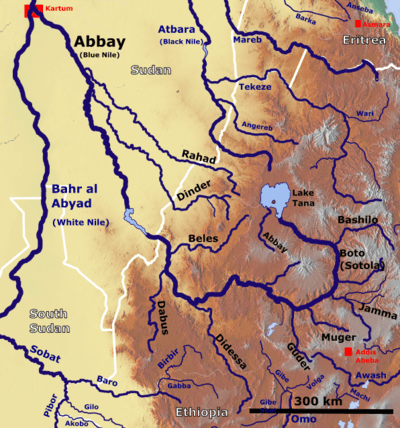Dabus River
The Dabus River is a north-flowing tributary of the Abay River in southwestern Ethiopia; it joins its parent stream at 10°36′38″N 35°8′58″E. The Dabus has a drainage area of about 21,032 square kilometers.[1]

This river was formerly known as the Yabus, and local speakers still refer to it by that name, without distinction for the Yabus in Sudan that is a tributary of the White Nile. Juan Maria Schuver was the first European explorer to determine that they were two separate rivers, and in 1882 proved false the rumor that these rivers flowed from the same mountain lake.[2]
It is important as a boundary both in cultural and political terms. According to Dunlop, who explored the region in 1935, the river is where "the Christian church of the Oromo people gives place to the mosque, and the Oromo greeting to the universal Muslim politeness: 'Salaam Aleikum.' In contrast to the Oromo and Amhara dress, consisting of a shirt with close-fitting sleeves, jodpurs and chamma, they wear a white skull-cap, pugaree, flowing coat with loose sleeves and baggy trousers."[3] In political terms, its course defines not only part of the boundary between the Benishangul-Gumuz and the Oromia Regions, but also the entire shared boundary of the Asosa and Kamashi Zones of the Benishangul-Gumuz Region.
The Dabus is a historically significant source for gold, where the local inhabitants used placer mining to recover the mineral.[4]
Notes
- "Tana & Beles Integrated Water Resources Development: Project Appraisal Document (PAD), Vol.1", World Bank, 2 May 2008 (accessed 5 May 2009)
- Wendy James, Gerd Baumann and Douglas H. Johnson, Juan Maria Schuver's Travels in North East Africa (London: The Hakluyt Society, 1996), pp. 132f
- A. Dunlop, "The Dadessa Valley", Geographical Journal, 89 (1937), p. 519
- Quoted in Richard Pankhurst, Economic History of Ethiopia (Addis Ababa: Haile Selassie I University, 1968), p. 233.
See also
- List of Ethiopian rivers